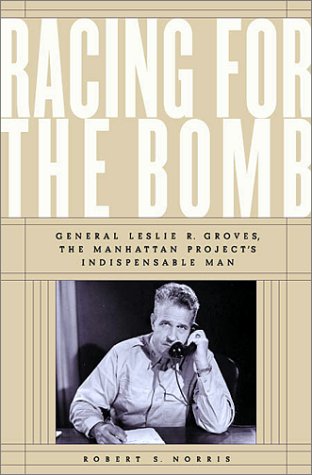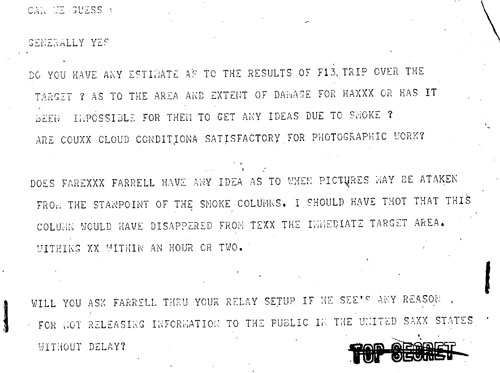Yesterday I had the honor of having a generously long meeting with Hans Kristensen, Steven Aftergood, and Stan Norris, all at the Federation of American Scientists. We had a nice free-wheeling conversation that had a tendency to return back to General Leslie Groves a number of times. Stan is, as most people reading this blog probably know, the author of the authoritative biography of General Groves, Racing for the Bomb: General Leslie R. Groves, the Manhattan Project’s Indispensable Man (Steerforth Press, 2002).
One thing that came up a number of times is the fact that Groves spent most of his time on the Manhattan Project not at Los Alamos, not at Oak Ridge, not a Hanford, but in the “New War Building” (now the Old State Department building) on 21st and Virginia, Northwest, Washington, D.C., not too far from where my wife and I regularly walk the dog on the weekends. Groves’ office, which now has a plaque noting its special status, was on the fifth floor.
Historians of science in particular are fond of emphasizing the importance of space in thinking about how ideas are transmitted, how technology is built, how organizations are run. Knowledge doesn’t just instantly transmit from one place to another: it has to be reduced to a transmissible form, it has to be put into systems of transmission, it have its meaning mangled in various ways as it jumps from one human brain to another.
The Manhattan Project had a lot of space. The numerous sites involved in the project were physically quite separated from one another, in an age where rail travel was still the most common form of long-range transportation, and where key Manhattan Project personnel were banned from using airplanes on the grounds that they were too valuable to risk to such a dangerous mode of transportation.
Tinian, the island from which the atomic raids on Japan were launched, was farther still. With a 15 hour time difference from Washington, D.C., on the other side of the International Date Line, it was no trivial thing to get in touch with someone on the tiny air-strip island. So when Groves knew that the Hiroshima bomb was finally scheduled to be used, he fretted about nervously. He had dinner at the Army-Navy Club, with his family, and then informed them that he was going to spend the night at his office, on a cot. Hours later than he had hoped it would be (there had been a delay in getting him the news), he finally heard that the Hiroshima raid had been a success.
This week’s document is of a “special teletype conference” between Major General Leslie Groves and Major General Curtis LeMay, the architect of the (horrific) strategic bombing campaign in the Pacific, and who under whose auspices the atomic bombs were actually being dropped. 1
I’ve included both the original transcript, and a “cleaned up” version that clarifies the speakers and removes the preparation material.
I like the “dirty” version the most. It has a raw look and feel to it that is oddly relatable in this day of instant chat and text messaging. You can tell how difficult it is to get this sort of conversation piece set up — operators have to be told to run and fetch the parties in question, wait for them to arrive, then translate their speech into unpunctuated messages, which included lots of “metadata” like corrections of typos, clarifications, and teletype operator code that looks terribly like what you’d expect a modern texter to use (“DID U GET THAT OM FINE TNKS … MIN PLS MIN PLS STAND BY OK TNKS”).
The other part that is of special interest to me is that one of the most important questions Groves had was whether they could announce it publicly in the United States. Again, I think we tend to imagine — when we aren’t being reflective about it — that the minute the bomb went off, people around the world knew it pretty immediately. Of course, that wasn’t quite the case. For hours the only people who knew about it were the Japanese and the servicemen on Tinian. Groves finally learned of it, and then hours later had to set up this conversation with Tinian, and then finally get the permission to send out the carefully-prepared press releases, Presidential statements, and so on, so that it would get picked up by the news outlets, and get to the rest of the world.
It was only after these world-spanning logistics that the facts-on-the-ground in Tinian became the facts-on-the-ground in the United States, and from there could become the facts-on-the-ground around the world.
- Teletype conference transcript between Leslie R. Groves and Curtis LeMay (6 August 1945), in Correspondence (“Top Secret”) of the Manhattan Engineer District, 1942-1946, microfilm publication M1109 (Washington, D.C.: National Archives and Records Administration, 1980), Roll 1, Target 6, Folder 5, “Events Preceding and Following the Dropping of the First Atomic Bombs at Hiroshima and Nagasaki,” Subfile 5H, “Damage Reports.” Note that the “cleaned up” version of the transcript has the date 8 August 1945, but this cannot be correct given the content of the conversation, as someone else has long ago noted on the document.[↩]





[…] conversation between Groves and Oppenheimer on the afternoon of August 6, 1945 — not long after Groves himself learned about the bombing of Hiroshima.2 Click on the image to view the full […]
My favorite story about slow communications was the Halloween night when Edward Teller monitored the seismograph at Berkeley and saw the wiglle that indicated the super had worked. He wired Dizy Graves, a physicist and the head of the stay-at-home contingent at Los Alamos that, “It’s a boy.”. She understood immediately, as she was waiting for her husband Alvin to send word from the island. He was delayed some hours doing that; in the meantime, she phoned the scientific group at Princeton. They were well into their party before Washington was officially informed.